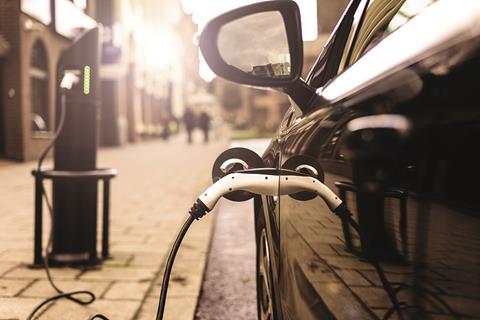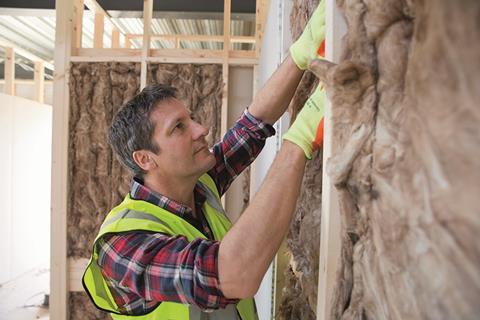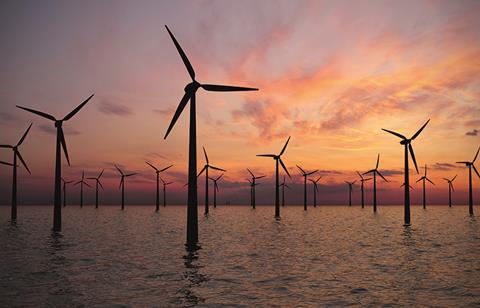A report by the Climate Change Committee sets out a host of ambitious carbon reduction targets and points to where resources need to be focused. Thomas Lane looks at three of the areas of most interest to construction and assesses what it will take to meet the targets

In a bid to burnish Britain’s sustainability credentials in advance of the COP26 conference in November, prime minister Boris Johnson recently announced that the UK was now targeting a 78% cut in carbon emissions by 2035. This establishes an interim target to the UK’s journey to net zero carbon by 2050.
It is a figure just 2% short of the UK’s original target of an 80% reduction in emissions by 2050, which was revised to 100% in 2019. The new 78% target includes the UK’s share of emissions from shipping and aviation; indeed this legally binding target is said to be the most ambitious in the world.
Is this another example of Johnson’s belief in the power of PR over physical action or a serious bid to clean up Britain’s emissions? The target comes from the Climate Change Committee (CCC), which advises the government on emissions reductions and recommended the 78% cut last December.

The 78% reduction is benchmarked against emissions in 1990 and, because these have come down over the past 20 years, this represents a 68% cut compared with 2019. Meeting the 2035 target requires an annual reduction of 21mtCO2e, not much more than the 19mtCO2e achieved since 2012. However, much of that reduction is due to switching away from coal to gas and renewables power generation, making the reductions to date relatively invisible.
The target is backed by a 450-page report detailing what areas need tackling and how this should be done to meet that annual 21mtCO2e cut; the wide range of areas covered include transport, power generation, agriculture, manufacturing and construction, with a whole section dedicated to buildings. It estimates that the UK needs to scale up its annual spending on cutting carbon emissions from the current £10bn to £50bn – with the money coming largely from private companies and individuals, although the energy savings should come close to balancing out the capital costs over the long term.
The report says resources need to be focused on increasing low carbon power capacity, building retrofit and the additional costs of batteries and infrastructure for electric vehicles. A dedicated heat and buildings strategy is due out this year which will detail how emissions from existing buildings will be cut, but there is plenty of information in the report to give the industry a good idea of what to expect over the next 15 years.
Here, we look at the three areas of most interest to construction: transport, buildings and manufacturing and construction.
SURFACE TRANSPORT
What the report says
Carbon emissions from surface transport were 113mtCO2e in 2019, making up 22% of the UK’s emissions. The report targets reducing this figure by 70% to 32mtCO2e by 2035. The report calls for the phasing out of petrol and diesel cars and vans by 2032, a date already beaten by government policy, which has set a date of 2030. It assumes a rapid increase in sales of battery electric vehicles during the 2020s.
Electrifying HGVs is a bigger challenge due to the large distances these cover in a day and the impact of heavy batteries on vehicle payload. Hydrogen is an alternative, although on-vehicle storage is also a challenge and refuelling infrastructure is virtually non-existent.

Nevertheless, the report calls for 96% of new HGV sales to be zero carbon by 2035 – although it acknowledges 67% of HGVs will still be powered by diesel. Petrol and diesel cars, vans and lorries will need to be more efficient in the run-up to being phased out; people should walk and cycle more to reduce car use; and HGV miles can be reduced by making greater use of micro consolidation centres in urban areas.
Costs
Electric cars are much more expensive to buy than their fossil-fuel-powered equivalents although cheaper to run. The report reckons the lifetime costs of electric car ownership will reach parity with conventional vehicles by 2025, with purchase costs reducing to the same point by the time these are phased out in 2030. Very few electric HGVs are currently available; the report expects the total cost of ownership to be higher than for conventional vehicles until 2035, with smaller zero carbon HGVs remaining more expensive overall up to 2050.
The big unknown is government response to the loss of fuel duty revenue which totalled £21bn last year, down from the previous year’s £28bn because of the pandemic. Assuming revenues grow again, £28bn represents about 3.5% of government receipts – so widespread adoption of electric vehicles will blow a big hole in the government’s pocket. One solution is variable road pricing where charges are based on distance, location, emissions and time of day. This could replace lost fuel duty revenues and provide a clear link between vehicle use and costs – which could drive down the amount people who drive and help accelerate the adoption of net zero vehicles.
Adoption challenges
Despite a rapid increase in sales, electric cars are currently very expensive to buy new, with a correspondingly limited second-hand market. Electric vehicle range has improved, but long journeys remain a challenge in many cars because of charging infrastructure issues. Availability of charging infrastructure is patchy, pricing is variable, plug standards vary and many charging networks need an account setting up in advance before they can be used.
Some local authorities are rolling out charging points in lampposts in partnership with the private sector, but the downside is that the electricity costs nearly double that sourced at home
A major barrier is that one-third of UK households are without off‑street parking, and councils can stop you from running a cable across the pavement – assuming you can park near your house in the first place. Some local authorities are rolling out charging points in lampposts in partnership with the private sector, but the downside is that the electricity costs nearly double that sourced at home, bringing the costs of running a medium-sized electric car close to that of a diesel vehicle. Rapid chargers are even more expensive to use.
The drive towards net zero construction is promoting the take-up of electric vehicles by contractors. For example, Keltbray has installed electric charge points at all its depots and plans to start trialling a Scania electric tipper truck next year once it becomes available. The construction industry is well placed to adopt electric HGVs, as daily mileages for delivery and site waste removal vehicles are relatively low.
BUILDINGS
What the report says
There were 87mtCO2e of emissions from buildings in 2019, which represents 17% of UK emissions. Of these emissions 77% come from homes, with heating the principal source. Progress in reducing emissions has flatlined since 2015 so the report calls for all new buildings to be zero carbon by 2025 at the latest. The Future Homes and Future �ڶ�����s Standards, which are in the process of being introduced, seek to address this by significantly reducing emissions from buildings through higher fabric standards and the widespread adoption of heat pumps.
Most of the section on buildings in the report is dedicated to existing buildings, because these are the main source of emissions. The report suggests a two-pronged approach, firstly bringing all homes up to an EPC rating of C with energy efficiency upgrades. Rented homes and those put up for sale would need to achieve an EPC rating of C or higher by 2028 and those with mortgages by 2033. A ban on oil boilers from 2028 and gas by 2033 would see these replaced by heat pumps, with homes easier to heat due to previously installed energy efficiency measures. Oil boilers would be banned in public and commercial buildings by 2026 and gas banned by 2030 and 2033 respectively.
The report acknowledges reducing emissions from buildings will be one of the most expensive challenges across the economy – £360bn will need to be invested by 2050
The report envisages energy efficiency upgrades would include insulated hot water tanks, draught‑proofing and insulation in wall cavities, floors and lofts, including top-ups where there is less than 200mm of insulation in roof spaces. Solid wall insulation would be fitted to 50% of uninsulated homes, despite the report saying there are uncertainties about the balance of costs and benefits and levels of public support.
The report claims that a typical house has cavity wall, floor and loft insulation installed, which reduces heat demand by 30%. A deep retrofit could achieve a reduction of 57%. Investment in heat pumps starts to ramp up from 2025; by 2030 heat pump sales should reach 1 million per year with a total of 5.5 million installations in homes by that date. The CCC sees hydrogen as an important contributor to reducing emissions, with trials rapidly expanding through the 2020s and heat networks playing a role too. It estimates that by 2030 domestic low carbon installations will be 75% heat pumps, including hydrogen hybrids, 19% will be low carbon heat networks and 5% will be other forms of electric heating.

Costs
The report acknowledges reducing emissions from buildings will be one of the most expensive challenges across the economy. It estimates £360bn will need to be invested by 2050, with £250bn going on upgrading homes and £110bn on public and commercial buildings. Some £45bn needs to be spent on domestic energy efficiency improvements by 2035, while £2bn needs spending each year up to 2030 on upgrading the energy efficiency of commercial buildings and £500m a year for public buildings to 2032, by which time all energy efficiency measures should have been installed. Investment continues through the 2030s and 2040s installing low carbon heating into commercial and public buildings: £2.8bn a year will be needed for commercial buildings and £0.9bn for public buildings. It is estimated this will save £3bn a year on bills. The report reckons the average cost of domestic energy efficiency measures is £10,000 per household, with 63% of homes needing just £1,000 spent on them.
Adoption challenges
Reducing emissions from new buildings should be relatively straightforward, provided the Future Homes and Future �ڶ�����s Standards are rolled out in a timely manner. The real challenge is reserved for existing buildings given the scale and cost of what needs to be done. Energy efficiency measures come first so need to be scaled up rapidly; the report estimates that loft insulation rates need to increase from 27,000 to 700,000 per year by 2025, cavity wall insulation rates increased from 41,000 a year to 200,000 a year and solid wall installations from 11,000 a year to 250,000 a year by 2025.
Upgrading an existing home with energy efficiency measures and a heat pump could cost over £40,000. The only way to make this palatable is through loans, extended mortgages and grants
The report reckons these figures are achievable as these are within the range achieved under the energy supplier obligations in the early 2010s. Solid wall installation rates are more ambitious but considered achievable too. Work needs to start soon on training people and building the supply chains to install low carbon heating systems as this starts ramping up with the phasing-out of fossil-fuel-fired boilers. The industry has had its fingers burnt twice with failed government initiatives to promote carbon reductions from homes, firstly with the Green Deal and secondly with the recently scrapped Green Homes Grant. It would not be a surprise if the industry were reluctant to invest in this area for a third time without a serious, convincing demonstration of intent from the government.
A major challenge is the cost. Although there may be some government help available, this is unlikely to come anywhere near the £250bn needed to upgrade existing homes. While there will be assistance for social housing, homeowners will be expected to stump up most of the cash themselves. If the average home needs £10,000 spent on energy efficiency measures with 63% of homes needing less than £1,000, that means 27% of homes – 7 million households – will need to find an average of £25,324. And heat pumps are extra: the report reckons an air-source heat pump costs £4,430, a figure that should be treated with a degree of caution. A BEIS report comparing the costs of different heating technologies quotes a figure of £8,750 for an 8kW air source heat pump installation, rising to £14,900 for a 16kW retrofit using existing radiators. That means upgrading an existing home with energy efficiency measures and a heat pump could cost over £40,000.
The only way to make this palatable is through loans, extended mortgages and grants. Interest rates would need to be competitive; one of the reasons why the Green Deal failed was that interest rates were higher than those available from high-street banks. The requirement for homes to have an EPC rating of C or better when put up for sale after 2028 could nudge people into action, or conversely make people reluctant to move if they need to spend thousands upgrading their homes first.
MANUFACTURING AND CONSTRUCTION
What the report says
Emissions need to be reduced by 70% by 2035 compared with 2018 levels; this equates to an annual 12mtCO2e reduction. Decarbonisation needs to be carefully managed to avoid manufacturing being driven overseas to countries with less onerous carbon reduction targets.
The manufacturing and construction emissions abatement strategy includes improvements in resource and energy efficiency, which in the case of buildings means optimising building design to reduce resource use. Recycling and reuse rates need to increase to reduce emissions by 3mtCO2e per year. Significantly for the industry, half of this figure will be achieved by the reuse of construction materials.

High carbon materials need to be phased out – for example, by increasing the use of cement substitutes and timber. Construction plant will need to be powered by electricity or hydrogen as emissions from off-road mobile machinery, of which 77% are construction vehicles, are 6mtCO2e annually. Emissions from cement production are to be reduced using low carbon energy sources and the carbon given off during production – which equates to 50% of emissions – captured using carbon capture and storage.
Costs
The annualised costs of abatement are £1bn a year in the late 2020s, going up to £2bn a year in the early 2030s and peaking at £3bn a year in the late 2030s, before dropping back to £2bn a year in the 2040s.
Adoption challenges
While the drivers to reduce embodied carbon in new buildings have increased significantly due to developers and public sector bodies adopting zero carbon targets, there is very little experience of doing it. That means it will take a while for the industry to get up to speed. There are bumps to overcome along the way – as an example, nervousness about the fire performance of timber is holding back more widespread adoption. Other challenges include the need to get to grips with designing materials for reuse. Reducing emissions from plant is also a challenge, as no satisfactory alternative to diesel-powered heavy equipment is currently available. Cutting emissions from cement production is also difficult, as carbon capture and storage is a technology that is still in its infancy. Whether these technologies develop quickly enough to meet the carbon reduction ambitions in the report remains to be seen.
Decarbonising the grid
Over half of the reductions the report says are needed will come from adopting low carbon alternatives to fossil-fuelled cars, heating and manufacturing processes. Electricity production must go from 50% low carbon to 100% by 2035, which will cut overall emissions by 18%.
At the same time electricity demand will increase by 50% by 2035 to power all those shiny new electric cars and heat pumps. Most of this will come from offshore wind, which will require significant investment – going from just under £5bn a year now to a peak of £15bn annually by 2035 before declining to £6bn a year by 2045. This will be partially offset by reduced operating costs.
The report assumes that nuclear power will remain part of the mix, with new projects replacing retired power stations. There will be a total of 10GW of nuclear power generation in 2035, with 8GB coming from new plants. Some 6% of power will come from hydrogen which has been made from natural gas with carbon capture.

Downloads
shutterstock_324590741
Other, Size 1.13 mbshutterstock_324590741
Other, Size 1.13 mb



























No comments yet